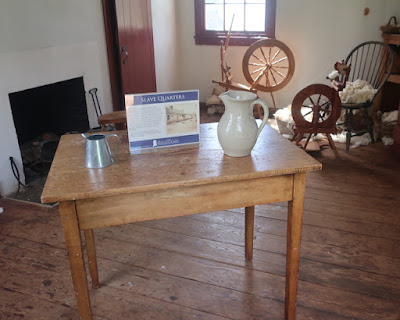James Monroe's Highland is the most consistent home that the fifth President of the United States had. Monroe built the house is 1799 and used it throughout his political career. He held many offices: Governor of Virginia; Ambassador to France, Great Britain, and Spain; and Secretary of State and of War. The main house was built in 1799, though visitors today have to stop first at a modern visitor's center just off the parking lot.
When we bought tickets to the tour, we discovered a unique opportunity. Included with admission is an "augmented reality" headset. A pair of special glasses and of normal headphones plug into a small pack that identifies where you are on the estate and plays video and audio descriptions of the location along with a lot of historical information.
The first stop on the AR tour was looking out over fields as the agriculture of the land was discussed. The Monroes mostly grew grain here in the early 1800s. Cotton soon became the dominant cash crop but the local soil and climate were not conducive.
The 1980s recreation of the slave quarters has displays on typical guest rooms in addition to the conditions under which the slaves lived. The 1810 census listed 49 slaves at Highland, though Monroe had other properties in Virginia and would move the slaves around depending on what projects were happening where.
The oldest building still on the property is actually three separate buildings added together. The original guest house was built in 1818 (on the left in the picture below). An addition was built in the 1850s with a few extra rooms. The yellow house is the Massey House, built in the 1870s by much later owners of the property.
In the basement of the guest house is another small exhibit on slave labor at Highland. The AR did a great job showing the people who were being described.
In front of the Massey House is a stone outline of the foundation of the 1799 house. That house burned down in the 1830s. Part of the foundation extends under the Massey House.
Down an avenue of shrubbery is a statue of Monroe by Attilio Piccirilli from Venezuela. It's a tribute to the Monroe Doctrine, which committed the United States to opposing any further colonization by European countries in the Americas.
As we finished the AR tour, our physical tour began. More on that in the next post.
 |
| Highland Visitor Center |
When we bought tickets to the tour, we discovered a unique opportunity. Included with admission is an "augmented reality" headset. A pair of special glasses and of normal headphones plug into a small pack that identifies where you are on the estate and plays video and audio descriptions of the location along with a lot of historical information.
 |
| Augmenting their experience! |
 |
| Map of the augmented reality tour |
The first stop on the AR tour was looking out over fields as the agriculture of the land was discussed. The Monroes mostly grew grain here in the early 1800s. Cotton soon became the dominant cash crop but the local soil and climate were not conducive.
 |
| For those without the AR kit |
 |
| The house garden |
The 1980s recreation of the slave quarters has displays on typical guest rooms in addition to the conditions under which the slaves lived. The 1810 census listed 49 slaves at Highland, though Monroe had other properties in Virginia and would move the slaves around depending on what projects were happening where.
 |
| Slave quarters |
 |
| What a guest room would have looked like in early 1800s |
 |
| A work room for the slaves |
 |
| Living quarters for the slaves |
The oldest building still on the property is actually three separate buildings added together. The original guest house was built in 1818 (on the left in the picture below). An addition was built in the 1850s with a few extra rooms. The yellow house is the Massey House, built in the 1870s by much later owners of the property.
 |
| Seeing the three buildings |
 |
| Guest house with 1850 addition on right |
In the basement of the guest house is another small exhibit on slave labor at Highland. The AR did a great job showing the people who were being described.
 |
| The kitchen area of the guest house |
 |
| Candle making equipments |
In front of the Massey House is a stone outline of the foundation of the 1799 house. That house burned down in the 1830s. Part of the foundation extends under the Massey House.
 |
| Outline of original house |
 |
| AR looking at the original house |
 |
| A white oak tree that dates back to the Monroe era |
 |
| Front view of the Massey House |
 |
| One of the old mile markers |
Down an avenue of shrubbery is a statue of Monroe by Attilio Piccirilli from Venezuela. It's a tribute to the Monroe Doctrine, which committed the United States to opposing any further colonization by European countries in the Americas.
 |
| What's down that path? |
 |
| Monroe looking scholarly |
 |
| Close up of the statue |
As we finished the AR tour, our physical tour began. More on that in the next post.



No comments:
Post a Comment